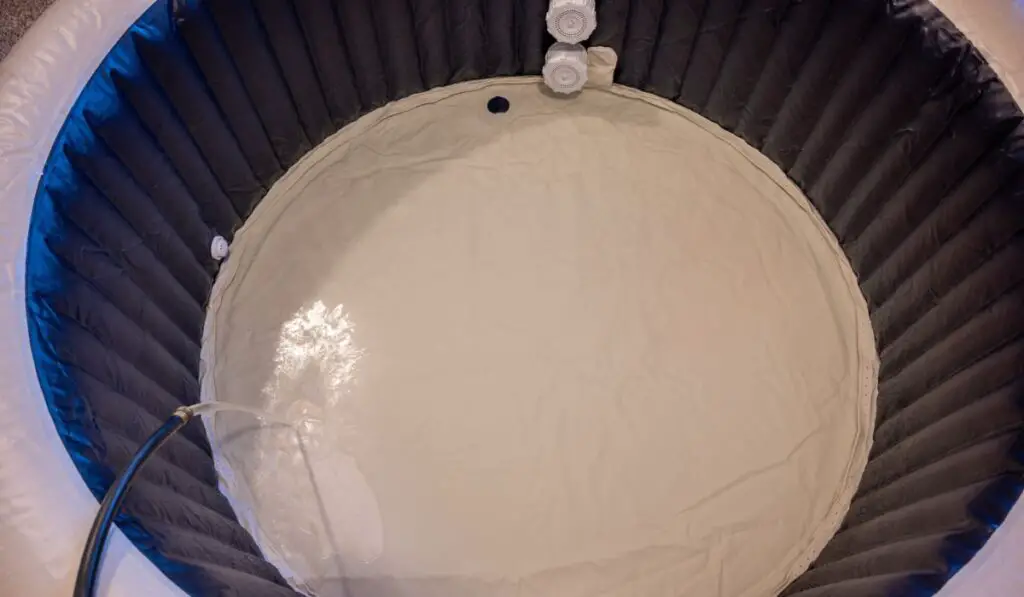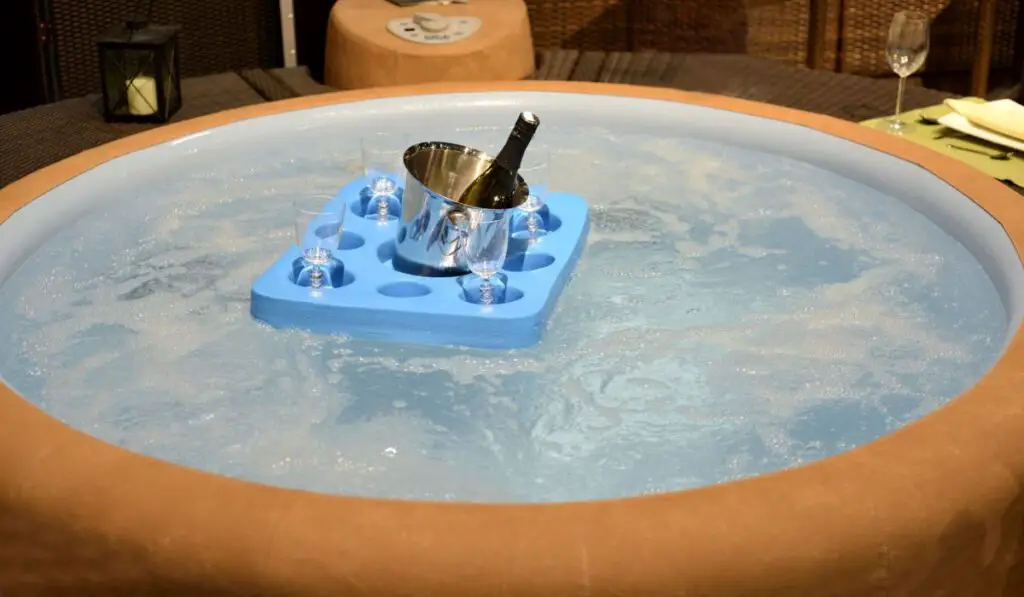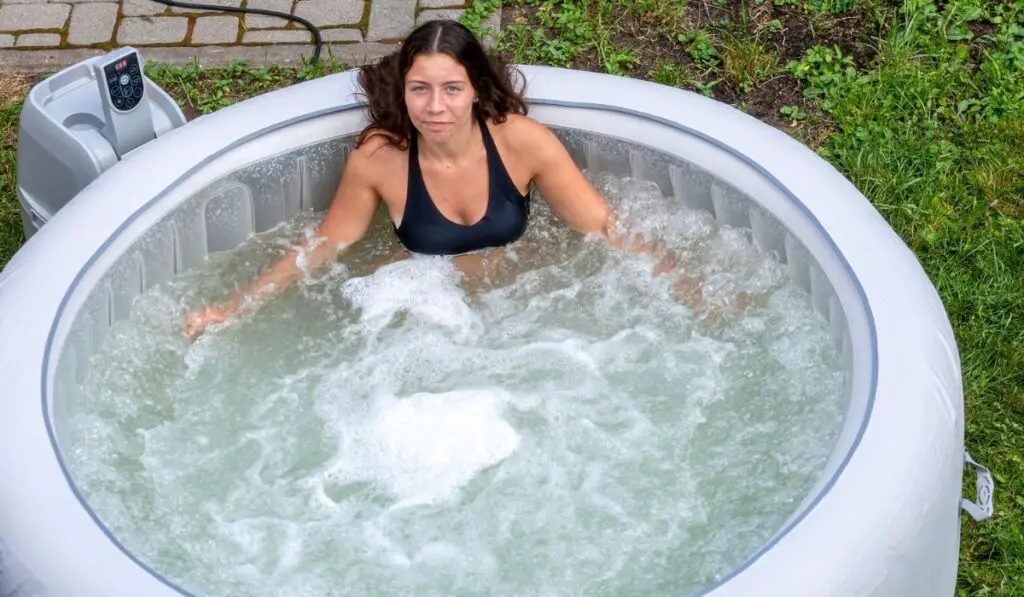Whether or not to invest in a hard-shell hot tub is a huge undertaking, and those who aren’t sure whether a hot tub will suit their lifestyle may want to consider an inflatable one. Of course, an inflatable hot tub has its benefits and drawbacks, but if you aren’t 100 percent ready to dive into a large commitment that will cost thousands of dollars, starting with a smaller trial hot tub might be your best bet.
An inflatable hot tub is portable, cheaper, and has a more straightforward setup. But it costs more in electricity, doesn’t have any seating, and only lasts a few years. However, An inflatable hot tub is best for new owners and those who don’t want to maintain a regular one constantly.
An inflatable hot tub’s biggest draw is the ease of use and portability. You can take it on trips or to events, set it up when you need it and take it down when it isn’t used. There are many reasons why an inflatable hot tub is the preference for many hot tub owners, but deciding if it is best for you can be challenging.
How to Decide Between an Inflatable vs. Regular Hot Tub?

Knowing if you should get an inflatable hot tub or a regular hot tub can be a daunting task to figure out. There are many things to consider, with substantial differences between each type of hot tub.
The Pros of an Inflatable Hot Tub
- Lower start-up investment
- Easy transportation
- Portability
- Able to be stored
- No steps required
- Locking spa cover
- Easy to operate
- Quick set up
The Cons of an Inflatable Hot Tub
- No seating
- Air jets rather than any massaging jets
- Slower to heat up and higher costs to maintain and run
- Not as deep
- Small filter
- Not as safe for children
- Disposable
An inflatable hot tub is great for first-time owners who are unsure how to maintain one, where they would like it to be located, or if they would even use one.
Suppose you are looking for a temporary hot tub for an event or specific season. In that case, it is best to go with an inflatable one since it has a cheaper initial cost and a less invasive installation process.
Lastly, people with lower budgets do well with inflatable hot tubs for the same reason. Unfortunately, hot tubs are expensive, and proper installation and placement are also quite expensive.
The Pros of a Regular Hot Tub
- Seating availability
- Targeted massage jets
- Lasts a long time
- Lower maintenance and running costs due to an increase in its efficiency
- Durability
- Aesthetically pleasing
The Cons of a Regular Hot Tub
- Higher start-up costs
- Not portable and is usually a permanent fixture
- Lifelong commitment
- Needs constant maintenance
- Requires winterizing if not used during colder months
Regular hot tubs are best for people that want to take on the lifetime responsibility of being a hot tub owner. A regular hot tub lasts about 15 years, making it a lifelong commitment, or at least until you move.
This kind of investment also pays off since, for 15 years, you won’t need to buy a new one, and with regular maintenance and care, it can continue to run with few required repairs.
Regular hot tubs are also more energy efficient, so people looking for smaller costs, in the long run, are better suited to invest in this type of hot tub rather than inflatable ones. Hot tubs are also more durable than their inflatable counterparts, which goes hand in hand with their longevity.
What are the Benefits of an Inflatable Hot Tub?

A regular hot tub can be costly and a permanent responsibility that not everyone is ready for. In addition, you might not have the proper layout in your yard or be able to maintain it.
If you have doubts about getting a hot tub, you might want to look at an inflatable one. There are many benefits to choosing to go with the inflatable hot tub over a regular one.
Lower Price Point
An inflatable hot tub is a great entry-level spa to purchase for new owners. They are reasonably low priced and allow people to try owning a hot tub before the massive investment of a regular one. There are also plenty of yearly sales for inflatable hot tubs, unlike more permanent ones, which rarely go on sale.
Easy Installation
Inflatable hot tubs are simple to set up. You plug them in a standard outlet rather than needing to hardwire your hot tub into its own breaker board by an electrician, like a regular hot tub. That kind of electrical work also adds an additional cost if going with a permanent hot tub type.
Like a regular hot tub, an inflatable one must be placed on a flat, solid surface that can support the weight of a spa filled with water and people. In addition, it should be positioned out of the wind to avoid a cold draft, but that is about it regarding placement requirements.
Getting your hot tub into your yard is also an easy task. However, with hot tubs, you can’t exactly purchase and take them home on the same day since they are massive units that require trucks to move.
An inflatable one is easy to load into a truck since it won’t be actually inflated, and it would be easy to maneuver into your backyard. So, an inflatable hot tub might be your best bet if you have narrow gates or a unique backyard layout.
Flexible Placement
Inflatable hot tubs are much more flexible regarding placement than regular hot tubs. A standard hot tub requires reinforcing a deck, and unique stone pavers, among other things, to get its location ready to meet the safety requirements.
An inflatable hot tub just needs a level spot that can hold the weight of maximum occupancy.
On top of this, inflatable hot tubs are much lighter than regular ones, so their requirements in the weight category will be a lot more flexible.
Easily Stored and Portable
An inflatable hot tub offers the convenience of being stored away when not in use—not going to use the hot tub in the winter? Instead, deflate it and store the unit in a shed until the following year. Then, you won’t need to winterize or maintain it through times of disuse like a regular hot tub.
Some people even take their inflatable hot tubs on vacation or camping since they are easily packed away and not difficult to travel with.
For those who love camping or RVing, this could be the benefit of an inflatable hot tub that tips the scales since who wouldn’t want to use their hot tub in the serene environment of a forest?
A Range of Sizes
Inflatable hot tubs don’t necessarily mean small. While you can opt for a more compact version of two or four people, an inflatable hot tub can get up to seven or eight people. Of course, this makes it more challenging to take camping with you, but it’s still possible.
A regular hot tub comes with some limitations regarding the size. It’s not so easy to upgrade if you realize you need a bigger size, and it comes in six or eight-seater sizes, limiting the options available.
Aesthetically Pleasing Backyard Addition
A hot tub, in general, offers a great look and feel to any backyard. An inflatable one can be moved as the season changes. For instance, it might be prettier to have the hot tub nearby if you have flowers in bloom.
Or trees with full foliage to offer some shade and privacy, but as the seasons change and the environment goes through its motions, the ideal location for your hot tub might shift with it.
Being able to pick where you place your hot tub at any given time can make a backyard look great all year round.
What is the Lifespan of an Inflatable Hot Tub?
The lifespan of an inflatable hot tub is the worst out of all kinds of hot tubs. An inflatable hot tub is often neglected and abused, resulting in a shorter lifespan of only a few years. However, an inflatable hot tub can last roughly five years with proper care and maintenance.
That initial investment usually maintains a regular hot tub more thoroughly. As a result, they are considered luxury items that people tend to favor in performing their ongoing maintenance requirements. A regular hot tub typically lasts 15 years but can go as long as 20 with proper care.
Is it Hard to Maintain an Inflatable Hot Tub?
Cleaning an inflatable hot tub isn’t very difficult, but it requires some unique maintenance steps since it can be taken down and put back up. Therefore, it’s not only important to clean your hot tub anytime you inflate it after it’s been in storage, but also to wipe it down before storing it, to begin with, or risk residue buildup on its walls.
- Remove any leaves and larger debris that could block the drainage valve.
- Drain the water by removing the nozzle or the valve. Sometimes, depending on the model of the hot tub, you need to attach a hose to it. Your best bet is to follow the manufacturer’s guide.
- Once the inflatable hot tub is drained of all water, use a damp microfiber cloth or sponge to clean the outside of the hot tub. If you find any stains, you can use mild detergent and warm water to scrub them out. Rinse thoroughly once it is wiped down, and avoid anything abrasive to scrub or risk damaging the surface.
- Wash the inside of the hot tub following the same technique as the outside. However, you don’t want to use any detergents that can create suds when you refill the hot tub. For stains, you can purchase a special hot tub cleaner (on Amazon). Rinse thoroughly.
- If storing the hot tub, let it dry completely before packing it.
- Deflate the hot tub if you are storing it, although the deflation method depends on the model.
Like with any hot tub, you want to perform proper maintenance to ensure the water is safe for use and the hot tub itself remains in proper functioning order.
- Maintain the proper water pH of 7.2 to 7.8.
- Keep the water clean with chlorine and bromine sanitizers.
- Regularly clean the filters.
Do Inflatable Hot Tubs Use a Lot of Electricity?

Inflatable hot tubs typically cost more to run on electricity than regular hot tubs. However, they aren’t always costly. Often it depends on the size of the hot tub, the temperature in which you are keeping the water, and outside conditions like the ambient temperature.
Generally speaking, a regular hot tub costs an extra $20 a month to run, while an inflatable costs about $40 to $50 a month.
A simple way to combat this spike in electricity costs is to leave the hot tub running. This may sound counterproductive, but the idea is that instead of using all that power to heat the water from scratch each time, you are only paying to maintain a constant temperature, lowering the amount of power the hot tub consumes over time.
Do Inflatable Hot Tubs Pop Easily?
One of the selling features of an inflatable hot tub is its easy setup. Most come in a box no bigger than a microwave oven and have a pop-up feature that expands once it’s taken out. This makes it incredibly easy and convenient to set up.
The average inflatable hot tub takes roughly 5 to 15 minutes to set up. However, filling the hot tub depends on how large it is and the water pressure, so the time it takes to get it up, and running can vary.
So, is an Inflatable Hot Tub Worth it?
What you want to get out of a hot tub and your lifestyle depends on whether an inflatable one is worth it.
If you are looking for a hot tub that you can move around the backyard, or take with you, then an inflatable one is for you. It can be taken down during winter or even travel with you because of its portable capabilities.
If you are looking for a permanent fixture in your yard that will be used all year round for many years, then you are probably better suited to look at a hard-shell hot tub.
So when deciding if an inflatable hot tub is for you, you need to consider your budget, how often you want to use the hot tub, and whether or not you will want to take it with you on various trips or events. But only you can answer whether an inflatable hot tub is worth it.
